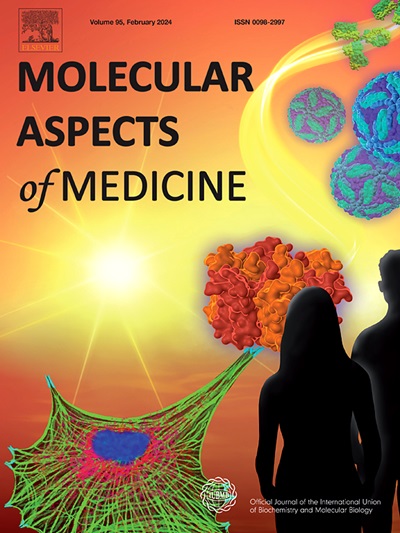Glycine receptors: Structure, function, and therapeutic implications
IF 10.3
2区 医学
Q1 BIOCHEMISTRY & MOLECULAR BIOLOGY
引用次数: 0
Abstract
Glycine receptors are considered as an integral part of higher brain function in mammals. The main function of glycine receptor is fast inhibitory transmission brought about by glycine neurotransmitter, its full agonist. This receptor is part of the glycinergic system which controls key physiological functions such as motor coordination, regulation of the rhythm of respiration and pain signalling. Glycine, a non-essential amino acid, causes hyperpolarisation within the glycine receptor, leading this ion channel to open and allow influx of chloride ion. The glycine receptor is found within the central nervous system and peripheral nervous system. It has also been found within amacrine cells, as well as renal medulla and cortex. The glycine receptor is a pentameric ligand-gated channel, part of the Cys-loop superfamily. It is composed of large ECD, C terminus, transmembrane domain M1-M4, and a 4α:1β glycine receptor subunit stoichiometry. The glycine receptor can be found as either homomeric or heteromeric subtypes. Alpha subtypes are crucial for important physiological functions such as breathing control and nociceptive system processing while the beta subunit aids in glycine receptor clustering and synapse stabilisation with its interaction with gephyrin scaffold protein. When hyperpolarised, the receptor transitions between close, open, and desensitised states. Factors that affect the activity and function of glycine receptors are gephyrin, ivermectin, strychnine and picrotoxin while certain endogenous modulators include partial agonists, positive allosteric modulator, antagonists, and bidirectional modulator are used for pharmacological modulation. Further studies need to be carried out on how glycine receptors are also implicated in chronic pain and nociception, epilepsy, autoimmune diseases and hyperekplexia.
甘氨酸受体:结构、功能和治疗意义
甘氨酸受体被认为是哺乳动物高级脑功能的一个组成部分。甘氨酸受体的主要作用是由甘氨酸神经递质带来的快速抑制传递。这种受体是甘氨酸能系统的一部分,它控制着关键的生理功能,如运动协调、呼吸节奏的调节和疼痛信号。甘氨酸是一种非必需氨基酸,在甘氨酸受体内引起超极化,导致离子通道打开并允许氯离子流入。甘氨酸受体存在于中枢神经系统和周围神经系统中。在无毛细胞以及肾髓质和皮质中也发现了它。甘氨酸受体是一种五聚体配体门控通道,是Cys-loop超家族的一部分。它由大ECD, C端,跨膜结构域M1-M4和4α:1β甘氨酸受体亚基化学计量组成。甘氨酸受体可以被发现为同型或异型亚型。α亚型对重要的生理功能至关重要,如呼吸控制和伤害系统处理,而β亚基通过与格phyrin支架蛋白的相互作用帮助甘氨酸受体聚集和突触稳定。当超极化时,受体在闭合、打开和脱敏状态之间转换。影响甘氨酸受体活性和功能的因素有格菲林、伊维菌素、士的宁和微毒素,而某些内源性调节剂包括部分激动剂、正变构调节剂、拮抗剂和双向调节剂用于药理学调节。甘氨酸受体在慢性疼痛和痛觉、癫痫、自身免疫性疾病和高丛症中的作用还需要进一步的研究。
本文章由计算机程序翻译,如有差异,请以英文原文为准。
求助全文
约1分钟内获得全文
求助全文
来源期刊

Molecular Aspects of Medicine
医学-生化与分子生物学
CiteScore
18.20
自引率
0.00%
发文量
85
审稿时长
55 days
期刊介绍:
Molecular Aspects of Medicine is a review journal that serves as an official publication of the International Union of Biochemistry and Molecular Biology. It caters to physicians and biomedical scientists and aims to bridge the gap between these two fields. The journal encourages practicing clinical scientists to contribute by providing extended reviews on the molecular aspects of a specific medical field. These articles are written in a way that appeals to both doctors who may struggle with basic science and basic scientists who may have limited awareness of clinical practice issues. The journal covers a wide range of medical topics to showcase the molecular insights gained from basic science and highlight the challenging problems that medicine presents to the scientific community.
 求助内容:
求助内容: 应助结果提醒方式:
应助结果提醒方式:


